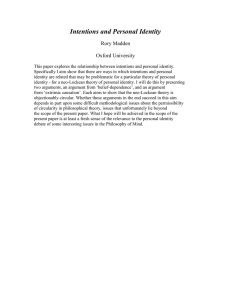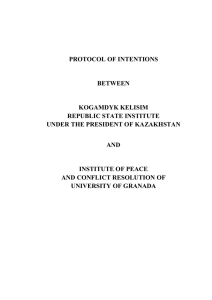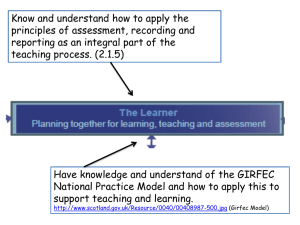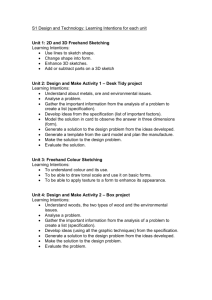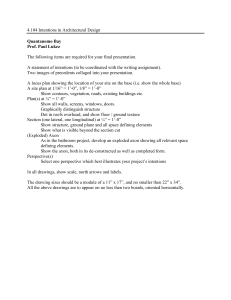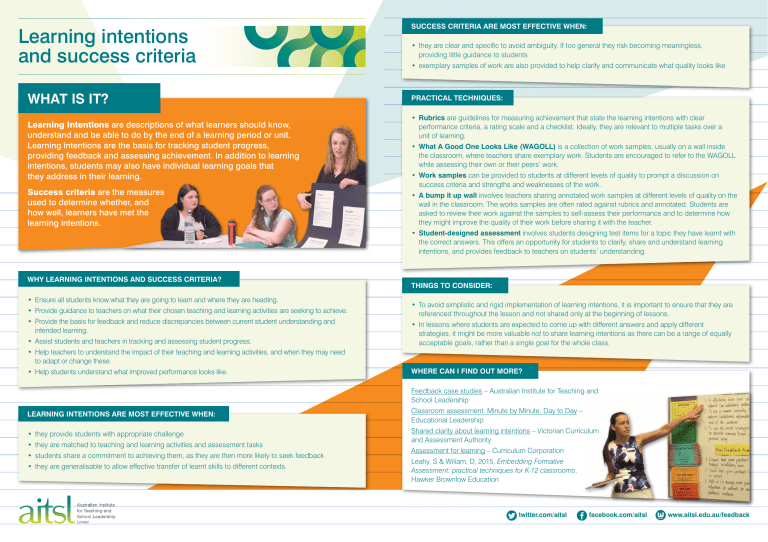
Learning intentions and success criteria WHAT IS IT? Learning Intentions are descriptions of what learners should know, understand and be able to do by the end of a learning period or unit. Learning intentions are the basis for tracking student progress, providing feedback and assessing achievement. In addition to learning intentions, students may also have individual learning goals that they address in their learning. Success criteria are the measures used to determine whether, and how well, learners have met the learning intentions. SUCCESS CRITERIA ARE MOST EFFECTIVE WHEN: • they are clear and specific to avoid ambiguity. If too general they risk becoming meaningless, providing little guidance to students • exemplary samples of work are also provided to help clarify and communicate what quality looks like PRACTICAL TECHNIQUES: • Rubrics are guidelines for measuring achievement that state the learning intentions with clear performance criteria, a rating scale and a checklist. Ideally, they are relevant to multiple tasks over a unit of learning. • What A Good One Looks Like (WAGOLL) is a collection of work samples, usually on a wall inside the classroom, where teachers share exemplary work. Students are encouraged to refer to the WAGOLL while assessing their own or their peers’ work. • Work samples can be provided to students at different levels of quality to prompt a discussion on success criteria and strengths and weaknesses of the work. • A bump it up wall involves teachers sharing annotated work samples at different levels of quality on the wall in the classroom. The works samples are often rated against rubrics and annotated. Students are asked to review their work against the samples to self-assess their performance and to determine how they might improve the quality of their work before sharing it with the teacher. • Student-designed assessment involves students designing test items for a topic they have learnt with the correct answers. This offers an opportunity for students to clarify, share and understand learning intentions, and provides feedback to teachers on students’ understanding. WHY LEARNING INTENTIONS AND SUCCESS CRITERIA? • Ensure all students know what they are going to learn and where they are heading. • Provide guidance to teachers on what their chosen teaching and learning activities are seeking to achieve. • Provide the basis for feedback and reduce discrepancies between current student understanding and intended learning. • Assist students and teachers in tracking and assessing student progress. THINGS TO CONSIDER: • To avoid simplistic and rigid implementation of learning intentions, it is important to ensure that they are referenced throughout the lesson and not shared only at the beginning of lessons. • In lessons where students are expected to come up with different answers and apply different strategies, it might be more valuable not to share learning intentions as there can be a range of equally acceptable goals, rather than a single goal for the whole class. • Help teachers to understand the impact of their teaching and learning activities, and when they may need to adapt or change these. • Help students understand what improved performance looks like. WHERE CAN I FIND OUT MORE? Feedback case studies – Australian Institute for Teaching and School Leadership LEARNING INTENTIONS ARE MOST EFFECTIVE WHEN: Classroom assessment: Minute by Minute, Day to Day – Educational Leadership • they provide students with appropriate challenge Shared clarity about learning intentions – Victorian Curriculum and Assessment Authority • they are matched to teaching and learning activities and assessment tasks • students share a commitment to achieving them, as they are then more likely to seek feedback • they are generalisable to allow effective transfer of learnt skills to different contexts. Assessment for learning – Curriculum Corporation Leahy, S & Wiliam, D, 2015, Embedding Formative Assessment: practical techniques for K-12 classrooms, Hawker Brownlow Education twitter.com/aitsl facebook.com/aitsl www.aitsl.edu.au/feedback

